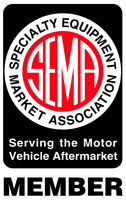Self-piercing rivets (SPR) join two or more pieces of material using a rivet without a pre-drilled hole. Self-piercing rivets are a semi-tubular rivet driven at high force through the material layers to be joined, into a die which causes the tail of the rivet to flare out and form a joint.
The process requires no hole preparation and delivers high static strength similar to, or better than, spot welding. This process produces a fatigue resistant joint that is stronger than spot welding and less susceptible to corrosion, which makes it ideal for automotive applications where welding may not be possible due to the use of coated, lightweight and high-strength materials, such as galvanized or pre-painted steel and aluminum. SPRs are used in many automotive applications, such as body panel assemblies, trim, and underbody components.

It’s important to mention that SPRs have a specific installation tool that is required for installation, also the selection of SPRs should be based on the thickness of the materials to be joined, and the specific load requirements of the application. The manufacturer’s instructions should always be followed when installing SPRs, as the specific instructions may vary depending on the brand and type of SPR used.
Ford Motor Company started using self-piercing rivets (SPR) in their aluminum bodies for a variety of reasons, including weight savings, cost savings, and improved performance.
One of the main reasons Ford started using SPRs in their aluminum bodies is that they are significantly lighter than traditional solid rivets. This is important for Ford, as reducing the weight of their vehicles can help improve fuel efficiency and performance. Using SPRs in their aluminum bodies allowed Ford to save weight without sacrificing strength or durability.
Another reason Ford started using SPRs is that they are less expensive and more efficient to use than traditional solid rivets. SPRs do not require pre-drilled holes, which saves time and labor during the assembly process. This can also reduce manufacturing costs.
SPRs are also more versatile than traditional solid rivets. They can be used to join materials of different thicknesses, and they can be used to join materials that are difficult to drill, such as aluminum or high-strength steels. This versatility allows Ford to use SPRs in a wider range of applications in the body of their vehicles, improving the overall performance of the vehicle.
In addition, SPRs offer a high strength-to-weight ratio, which helps improve the overall performance of the vehicle. SPRs are also a more sustainable option than traditional solid rivets, as they produce less waste and require less energy to manufacture.
It’s important to note that Ford was not the first automaker to start using SPRs, but they were one of the first to adopt the technology and use it extensively, Ford began using SPRs extensively in their 2015 F-150, which was the first mass-produced aluminum-bodied vehicle in North America.
Ford F-150 Self-Piercing Rivets and Locations
| Henry’s Part # | Ford OEM # | Code | F-150 Location | Overall Length | Body Diameter | Inside Diameter | Head Diameter | Head Style |
|---|---|---|---|---|---|---|---|---|
| WF79526 | W708713-S900 | AS | Cab, Rocker, Door, Cowl, Back Panel | 5.00mm | 5.40mm | 3.35mm | 7.80mm | Solid |
| WF79536 | W708714-S900 | AT | Cab, Back Panel | 6.05mm | 5.30mm | 3.35mm | 7.80mm | Solid |
| WF79546 | W708717-S900 | AW | Door | 8.05mm | 5.30mm | 3.20mm | 7.80mm | Solid |
| W710246-S900 | BN/DB | Cab, Door, Cowl, Back Panel | 7.05mm | 5.30mm | 3.15mm | 7.80mm | Solid | |
| W717182-S900 | QC | Hinge Pillar | 10.00mm | 5.30mm | 3.15mm | 7.80mm | Hollow | |
| WF79556 | W717184-S900 | QA | Door | 9.05mm | 5.30mm | 3.15mm | 7.80mm | Hollow |
| WF79556 | W717185-S900 | EL | Door, Hing Pillar | 9.05mm | 5.30mm | 3.20mm | 7.80mm | Solid |
| WF79546 | W717186-S900 | EN | Cab, Door | 8.05mm | 5.30mm | 3.15mm | 7.80mm | Solid |
| W717337-S900 | PX | Door | 7.55mm | 5.30mm | 3.20mm | 7.80mm | Solid | |

